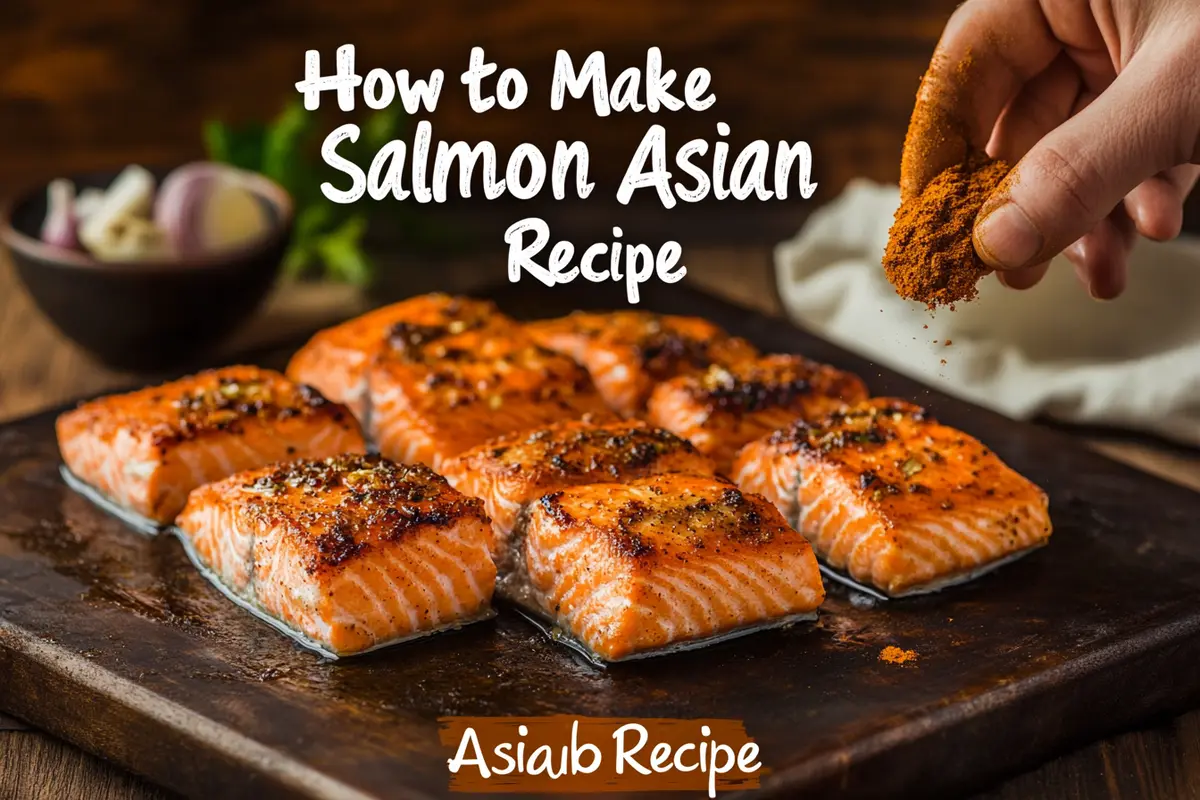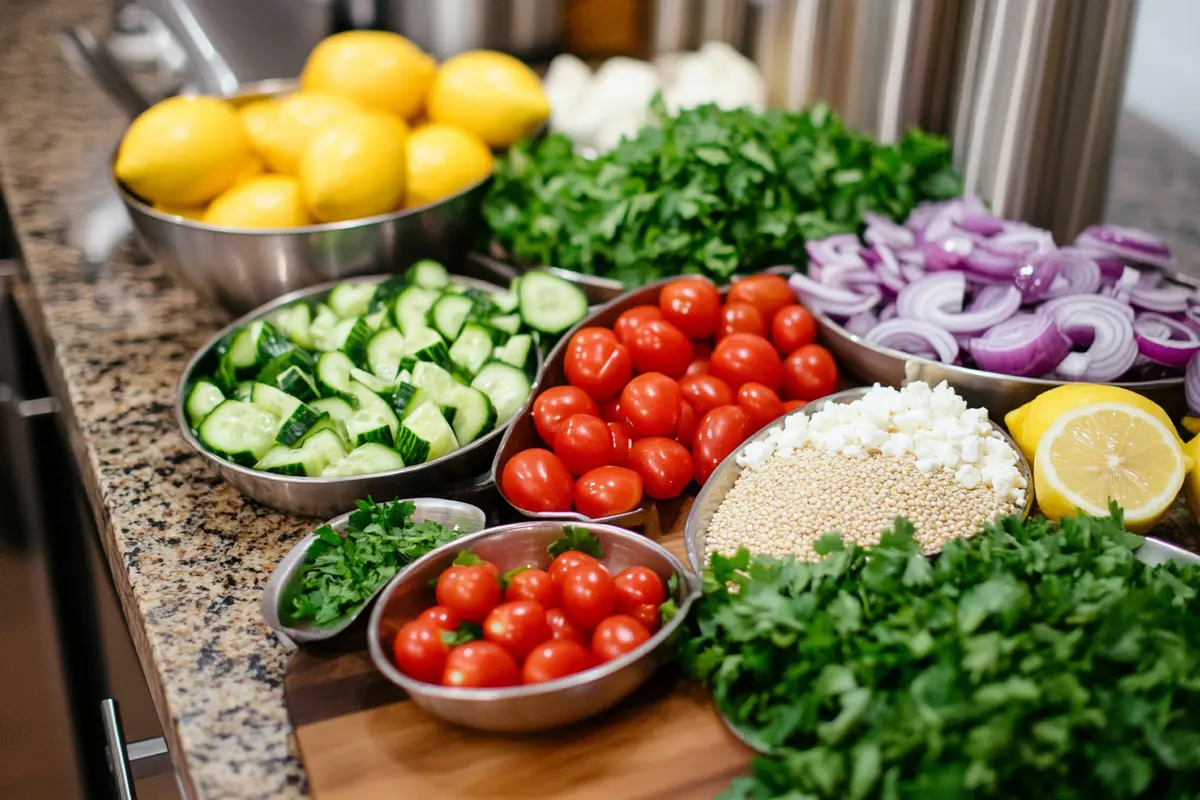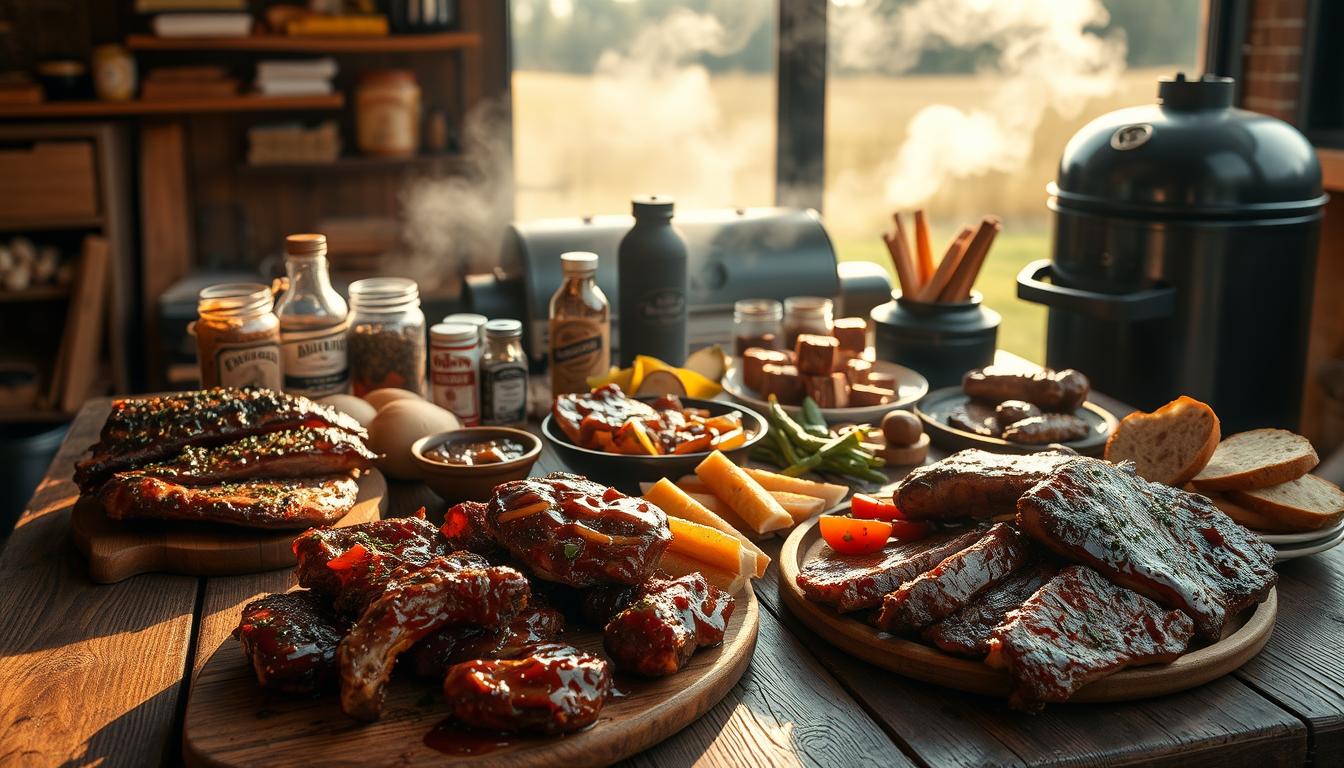Salmon Asian Rub Recipe
It’s time to learn how to craft a Salmon Asian Rub Recipe that truly stands out. Many people seek a perfectly spiced fish dish that balances savory, sweet, and spicy elements. Fortunately, this guide walks you through every step in a friendly, conversational manner. Consequently, you will discover how to pick the ideal salmon, assemble a knockout rub, and cook it to tender perfection.
This flavorful recipe will make your salmon the center of attention at any meal. Moreover, the Asian-inspired twist combines bold ingredients like soy sauce, ginger, garlic, chili flakes, and a subtle hint of sweetness. Salmon Asian Rub Recipe is easy to customize, making it perfect for everyone—whether you’re a fan of bold heat or milder tastes. Read on to see how simple it can be to transform salmon from an everyday protein into a culinary delight that bursts with richness and complexity.
Throughout the following sections, you’ll learn about the must-have components that create the base of this dish. Additionally, you’ll discover cooking strategies that deliver crisp edges, a juicy interior, and a luscious balance of flavors. In essence, this is your one-stop resource for mastering a Salmon Asian Rub Recipe that shines at family dinners or dinner parties. Enjoy the journey, and prepare to impress everyone who tastes it.
1. Understanding the Appeal of a Salmon Asian Rub
Salmon is already a beloved fish, prized for its balance of healthy fats and distinctive taste. Accordingly, pairing it with an Asian-style rub enhances its natural richness through a fusion of sweet, salty, tangy, and spicy undertones. Indeed, Asian cuisine often focuses on combining multiple flavor profiles in a single bite, and salmon’s fatty texture welcomes these dynamic tastes.
This approach resonates with people seeking bold seasonings that complement the fish instead of overpowering it. Particularly, ingredients like ginger, garlic, soy sauce, and brown sugar highlight the salmon’s buttery quality. Because salmon is forgiving, it won’t dry out easily if you follow basic cooking tips. Consequently, the dish becomes both approachable and delicious, making it a favorite for busy weeknights or special occasions alike.
Furthermore, salmon offers impressive nutritional benefits that make it appealing to health-conscious individuals. Its omega-3 fatty acids support heart health, and it’s loaded with protein. Adding vibrant spices and minimal oil ensures that your meal remains nutritious without compromising on flavor. Meanwhile, the process of creating an Asian rub remains simple, allowing even novice cooks to succeed on the first try.
2. Selecting the Right Salmon for Your Recipe

2.1 Fresh vs. Frozen Salmon
Many people wonder whether fresh or frozen salmon works best for a Salmon Asian Rub Recipe. Fresh salmon is excellent when you have access to a reputable fishmonger. However, high-quality frozen salmon can be just as good. Indeed, many fisheries flash-freeze their catch immediately, preserving freshness and nutritional content. If you choose frozen, defrost it properly in the refrigerator overnight. Consequently, you’ll preserve texture and flavor.
2.2 Wild-Caught vs. Farm-Raised
Wild-caught salmon and farm-raised salmon differ in taste and texture. Wild salmon often boasts a leaner fillet and more robust flavor. Comparatively, farm-raised salmon tends to have a milder, fattier profile. Neither is strictly better than the other; it depends on availability, budget, and personal preference. Therefore, select the one that fits your taste and wallet.
2.3 Inspecting Salmon Quality
Look for fillets with a vibrant color and no bruising or discoloration. The salmon should smell clean, like the ocean, with no off odor. Additionally, the flesh should be firm to the touch and not mushy. If you purchase a whole fish, check that the eyes are clear and bright. These signs ensure you’re starting with a top-quality ingredient. Ultimately, choosing a fresh, flavorful piece of salmon is the foundation of any successful Salmon Asian Rub Recipe.
3. Essential Ingredients for a Bold Salmon Asian Rub
3.1 Dry Elements
- Garlic Powder or Minced Garlic: Garlic adds a savory depth that complements salmon’s natural richness. Minced garlic offers a sharper taste, whereas powdered garlic integrates more smoothly into a rub.
- Onion Powder: A pinch of onion powder boosts the overall flavor profile without overwhelming the other ingredients.
- Ginger (Fresh or Powdered): This warming spice infuses a gentle heat and slightly sweet note. Fresh ginger delivers more bite, whereas powdered ginger is subtler.
- Chili Flakes or Cayenne: Including chili provides a piquant kick. Feel free to adjust the amount based on how spicy you want your fish to be.
3.2 Liquid Components
- Soy Sauce or Tamari: Both deliver a robust, salty element. Tamari is a gluten-free alternative that offers a similar taste.
- Brown Sugar or Honey: A sweetener tames the salt and spice. Honey can help create a sticky glaze, while brown sugar may caramelize more easily.
- Sesame Oil (Optional): This nutty oil enriches the rub, but a small drizzle goes a long way.
3.3 Supporting Flavors
- Salt and Pepper: Basic seasonings that underscore all other components.
- Citrus (Optional): Lime juice or rice vinegar brightens the overall taste, cutting through the salmon’s fattiness.
Combining these ingredients in proper proportions creates a balanced, multilayered flavor that sets this dish apart. Take time to measure and adjust these seasonings to align with your palate. Indeed, the beauty of a rub is its flexibility. Experiment freely to discover your perfect ratio.
4. Balancing the Flavor Profiles
In an Asian rub, the goal is to achieve a delicious equilibrium of sweet, salty, tangy, and spicy. Therefore, each element should enhance—not dominate—the rest. When you first mix your rub, taste a small bit before slathering it onto your fish. Because the salmon will mellow strong flavors, err on the side of slightly bold. However, avoid extremes. Excess salt or sugar can ruin the dish, so measure carefully.
Furthermore, if you prefer a sweeter profile, add extra honey or brown sugar. Conversely, if you crave a more savory taste, use extra soy sauce or a hint of fish sauce. Meanwhile, those who love spice can increase the chili flakes or cayenne. The point is to make the recipe your own. Consequently, your salmon will reflect personal taste preferences while still resonating with the core concept of an Asian rub.
Remember that these spices work in unison with the salmon’s natural oils. The fatty nature of salmon helps distribute flavors throughout the fillet during cooking, ensuring each bite is bursting with taste. Because of this synergy, the dish remains simultaneously rich and vibrant.
5. Preparing Your Salmon for the Asian Rub
5.1 Thawing and Drying
Initially, ensure your salmon is thawed if it was frozen. Let it thaw in the refrigerator to maintain quality and avoid partial cooking in the microwave. Pat the fillets dry with a paper towel. This simple step helps the rub adhere thoroughly to the fish. Subsequently, you’ll achieve an even coating that doesn’t slip off when heat is applied.
5.2 Removing Pin Bones
Pin bones can make eating fish unpleasant. Consequently, it’s wise to remove them before cooking. Slide your fingers along the fillet to detect any bones, then extract them gently with kitchen tweezers. By removing these small bones, you guarantee a smooth dining experience for everyone at your table.
5.3 Portioning
For portioning, each person typically needs around 6 ounces of salmon. However, some may prefer bigger or smaller servings. You can also leave the salmon as one large piece if you plan to bake it. If you prefer direct contact with heat in a pan or on a grill, individually portioned fillets may cook more evenly. Decide based on your chosen cooking method and your guests’ appetites.
6. Crafting and Applying the Salmon Asian Rub
6.1 Mixing Your Rub
Begin by combining the dry elements—garlic powder, onion powder, chili flakes, ginger, salt, and pepper—in a small bowl. After that, add the soy sauce (or tamari) and a sweetener such as brown sugar or honey. Stir the mixture until it forms a paste-like consistency. In some cases, you might add a teaspoon of sesame oil for extra nuttiness. Yet, be cautious not to overdo it.
Taste the rub once blended. Although it might taste more intense than you expect, salmon will dilute it somewhat during cooking. If it’s too mild, add a pinch of salt or a dash of chili flakes. Conversely, if it’s overpoweringly salty, you can mix in a bit more sugar or a drop of water. Keep adjusting until you strike the perfect balance.
6.2 Coating the Salmon
Next, spread the rub evenly across the surface of your salmon. If you’re cooking the salmon skin-on, you can concentrate the rub on the flesh side. Let it sit for at least 10 to 15 minutes. This short marination period allows the flavors to start infusing the fish. Additionally, avoid over-marinating if you have any acidic ingredients in the rub because they can alter the salmon’s texture.
6.3 Helpful Tips
- Tip 1: Use a basting brush or the back of a spoon to apply the rub without making a mess.
- Tip 2: Cover the salmon and let it rest in the refrigerator if you plan to wait longer than 15 minutes.
- Tip 3: Sprinkle extra chili flakes on top if you want a stronger kick.
The goal is a generous, even coating that seeps into the fillet, ensuring each bite bursts with savory, sweet, and spicy goodness.
7. Cooking Methods: Which One Suits You Best?

Cooking technique has a huge impact on the final outcome of your Salmon Asian Rub Recipe. While salmon is versatile enough to handle various styles, each method imparts unique characteristics. Additionally, your equipment and personal taste might guide your decision.
7.1 Oven-Baking
Oven-baking is a hands-off approach that yields tender, evenly cooked salmon. Therefore, it’s popular for busy cooks or those hosting gatherings. To bake, preheat your oven to 400°F (200°C). Arrange the fillets on a lined baking sheet, rub-side up. Bake for about 12-15 minutes, depending on fillet thickness. You’ll know it’s done when the salmon flakes easily and reaches an internal temperature of 145°F (63°C).
This technique is advantageous if you’re preparing multiple fillets simultaneously since the oven can accommodate a large tray. Moreover, you won’t have to babysit the fish, allowing time to prep side dishes or greet guests.
7.2 Pan-Searing
Pan-searing delivers a crispy exterior and a luscious interior. Initially, warm a skillet over medium-high heat with a drizzle of cooking oil. Once hot, place the fillets flesh-side down if they have skin. Sear for around three to four minutes. Then flip and cook another two to three minutes. Control your heat to avoid burning the rub’s sugar content. If it’s browning too rapidly, reduce the temperature. Meanwhile, keep an eye on the fillet’s center to avoid overcooking.
Pan-searing suits individuals who love a caramelized crust. However, it requires vigilance to ensure the rub doesn’t scorch. Keep a spatula handy and be prepared to flip if the sugar starts blackening.
7.3 Grilling
Grilling imparts a smoky aroma that pairs exceptionally well with an Asian-style rub. Begin by preheating your grill to medium-high heat. Lightly oil the grates to prevent sticking. Place the salmon fillets skin-side down, and close the lid. Cook for about four to five minutes before flipping carefully. Grill the other side for an additional three to four minutes, ensuring the fillet reaches 145°F (63°C).
For fewer flare-ups, consider using a piece of aluminum foil under the fish. Because sugar can caramelize quickly, pay close attention and move the fillets to indirect heat if necessary. The final result is a slightly charred, deeply flavored salmon that’s perfect for outdoor dining.
7.4 Air-Frying
An air fryer replicates the crispiness of frying without excessive oil. Preheat the air fryer to around 380°F (193°C). Lightly coat the basket with nonstick spray or a small amount of oil. Place the salmon fillets inside, leaving space so air circulates effectively. Cook for 10-12 minutes, depending on thickness. The rub will caramelize nicely, and the salmon will emerge succulent.
Air-frying is ideal for smaller kitchens or those who want minimal cleanup. Nonetheless, cook in batches if you have multiple fillets, ensuring each piece has enough room to crisp properly.
8. Simple Side Dishes to Complement Your Salmon
8.1 Rice, Noodles, or Grains
- Steamed Rice: Jasmine or basmati rice absorbs excess sauce, making each bite flavorful.
- Fried Rice: Add vegetables and eggs for extra flair. Because the salmon itself is bold, a simple egg-and-vegetable mixture often works best.
- Soba or Udon Noodles: These noodles pair brilliantly with soy-based flavors, especially when tossed in sesame oil and green onions.
8.2 Vegetable Medleys
- Stir-Fried Veggies: Carrots, bell peppers, and snap peas provide crunch and sweetness. A light drizzle of soy sauce and garlic can unify the flavors.
- Grilled Asparagus: Quick to cook and garnished well with sesame seeds or a squeeze of lime.
- Roasted Broccoli: High-heat roasting yields crispy edges and a mild, earthy taste that stands up to salmon’s bold rub.
8.3 Refreshing Salads
- Mixed Greens with Asian Dressing: Drizzle with a ginger-sesame vinaigrette for a light, tangy component.
- Cucumber Salad: Marinate thin cucumber slices in rice vinegar, sugar, and chili for a cool, crunchy bite.
- Slaw Variations: A cabbage slaw with carrots, onions, and a sweet-and-sour dressing offers contrast to the savory salmon.
Each side dish can highlight the distinct flavors in your Salmon Asian Rub Recipe. Especially when planning a meal, consider balancing heavier components like rice with lighter veggies or fresh salads. Alternatively, you could make everything revolve around smoky and spicy notes by adding grilled vegetables. Indeed, the possibilities are vast.
9. Common Mistakes to Avoid
Although cooking salmon is generally straightforward, certain pitfalls can derail your experience. Hence, being aware of these issues helps you navigate them with confidence.
9.1 Overcooking the Salmon
Salmon can dry out rapidly once it surpasses an internal temperature of 145°F (63°C). Therefore, use a thermometer or perform a quick “fork test.” If the flesh flakes easily, it’s done. Overcooked salmon becomes tough and loses much of its appeal, so timing is critical.
9.2 Using Too Much Salt
Soy sauce brings ample salt, and certain spice blends also contain sodium. Taste your rub as you go and exercise caution. If you oversalt, add a bit more sugar or water to counterbalance. Remember that you can always add salt later if it’s underseasoned.
9.3 Burning the Sugar
Brown sugar and honey caramelize quickly. Thus, watch your heat levels closely. Turn down the stove or move the fish to indirect heat on a grill if you notice the rub darkening too fast. Burning the sugar creates a bitter taste that can overshadow the salmon’s natural flavor.
9.4 Failing to Dry the Fish
A wet fillet prevents the rub from adhering effectively. Patting the salmon dry is a small step that significantly improves the outcome. Otherwise, you might encounter uneven seasoning or a watery texture on the surface.
By steering clear of these mistakes, you’ll safeguard the flavor and texture of your meal. Undoubtedly, avoiding these pitfalls also boosts your confidence in the kitchen. Cooking success often lies in such simple details.
10. Frequently Asked Questions
10.1 Can I Use This Rub on Other Types of Fish?
Yes, the same Asian rub can elevate cod, tilapia, halibut, or even shrimp. Adjust cooking times accordingly, as leaner fish may cook faster than salmon. Similarly, be mindful of the rub’s intensity because milder fish might need less seasoning.
10.2 Should I Remove the Skin Before Applying the Rub?
That depends on your preferred cooking method. If you plan on grilling or pan-searing, leaving the skin on can protect the flesh from direct heat. It also becomes crispy when seared properly. If you don’t enjoy fish skin, feel free to remove it beforehand. Ultimately, the rub still shines either way.
10.3 How Long Can I Store Leftover Rub?
If you make a dry rub without fresh garlic or ginger, you can store it in an airtight container for a few weeks. Adding wet ingredients like soy sauce or honey shortens its shelf life. In that case, it’s best to use the mixture immediately or within a couple of days if refrigerated.
10.4 What Are the Best Ways to Reheat Cooked Salmon?
Reheat salmon gently to preserve its moisture. For instance, warm it in the oven at a low temperature (around 275°F/135°C) for 10-15 minutes. A quick microwave reheat can work too, but choose low power and brief intervals to avoid drying out the fish.
10.5 Is This Recipe Suitable for Meal Prep?
Absolutely, salmon reheats decently if managed carefully. Cook a few fillets in advance and store them in sealed containers. Combine them with grains and steamed vegetables for a balanced meal throughout the week. Just avoid overcooking the salmon initially, so it doesn’t become dry upon reheating.
11. Enhancing the Salmon Asian Rub Recipe with Extra Flavors
11.1 Spice It Up with Different Peppers
Although chili flakes are common, you can explore gochugaru (Korean red pepper flakes) or finely chopped fresh chiles for extra heat. Indeed, each pepper variety adds its own distinct flavor profile. This approach keeps your recipe feeling fresh and exciting every time you cook it.
11.2 Experiment with Umami Boosters
To deepen the savory aspect, add a teaspoon of miso paste or a splash of fish sauce into the rub. Furthermore, a small pinch of dried mushrooms (like shiitake) ground into powder can deliver a potent umami boost. Be careful to keep the balance, as strong umami can become overwhelming if you go overboard.
11.3 Try Citrus Zest or Fruit Juice
For a hint of brightness, incorporate lemon or lime zest in the rub. Another idea is to drizzle fresh orange juice, which complements the sweet-savory tones. The key is moderation; a small quantity can transform your salmon without clashing with the other flavors.
12. Serving Suggestions Beyond the Usual Sides
12.1 Tacos and Wraps
Break up your cooked salmon and place it in tortillas, pitas, or lettuce wraps. Add crunchy vegetables, a drizzle of sriracha mayo, and a sprinkle of cilantro. Consequently, you’ll have a quick lunch or dinner that feels new and exciting.
12.2 Poke-Style Bowls
Dice your cooked salmon and assemble a rice bowl with edamame, avocado, cucumber, and nori strips. Finish with a light sesame dressing. This approach merges the concept of a poke bowl with the robust taste of the Salmon Asian Rub Recipe.
12.3 Pasta Creations
Toss flaked salmon with soba noodles or even spaghetti. Mix in stir-fried vegetables and an Asian-inspired sauce containing soy, ginger, and sesame oil. Thus, the salmon transitions from a standalone entree to a hearty component in a fusion dish.
These creative serving ideas allow you to repurpose your salmon in imaginative ways. Rather than sticking to the same format, you can explore global culinary techniques that highlight the fish’s versatility.
13. Storing and Reheating Leftovers
13.1 Proper Storage Techniques
Leftovers are inevitable if you prepare multiple servings. Place your cooked salmon in an airtight container and refrigerate it promptly. Generally, salmon remains fresh for two days in the fridge. However, avoid waiting too long to enjoy it because fish deteriorates quickly once cooked.
13.2 Reheating Safely
Use a gentle heat source like a low oven setting (around 275°F/135°C) or a microwave on reduced power. Additionally, keep a close eye on the salmon’s texture; you only want to warm it, not cook it again. Consequently, you’ll preserve moisture and retain the rub’s flavor without turning the fish rubbery.
13.3 Ideas for Leftover Salmon
As previously mentioned, leftover salmon can star in salads, wraps, and grain bowls. Another option is to make salmon cakes by flaking the fish and mixing it with breadcrumbs, egg, and seasonings. This method transforms your Salmon Asian Rub Recipe into an entirely new dish, reducing food waste and saving you time.
14. Health Benefits of Salmon and Asian Spices
Salmon ranks highly among dietitians due to its robust nutritional profile. Specifically, its omega-3 fatty acids are associated with heart health, cognitive function, and reduced inflammation. Likewise, salmon is rich in protein and B vitamins, supporting energy production and muscle maintenance.
Meanwhile, adding spices like ginger, garlic, and chili can have additional health perks. Ginger may help reduce inflammation and soothe digestion. Garlic contains antioxidants and can support immune function. Chili peppers also contain capsaicin, which some studies link to metabolic benefits. While no single food is a cure-all, combining nutrient-dense salmon with beneficial spices makes for a wholesome meal that doesn’t sacrifice flavor.
Because you’re cooking with minimal oil and focusing on robust seasonings, this approach fits seamlessly into a balanced diet. Pair your salmon with fiber-rich vegetables or whole grains, and you’ll have a comprehensive meal that satisfies both taste and nutritional needs.
15. Conclusion
Crafting a Salmon Asian Rub Recipe unlocks a world of vibrant flavors that showcase the best qualities of this beloved fish. By selecting high-quality salmon, mixing a balanced rub, and choosing a suitable cooking method, you ensure each bite is an explosion of savory, sweet, and spicy elements. Moreover, this preparation style highlights salmon’s natural richness without overshadowing it. The result is a dish that appeals to a wide variety of palates—be it spice aficionados, those with a sweet tooth, or individuals who prefer milder tastes.
For more ideas on how to handle or source quality salmon, you can check reputable resources like Seafood Health Facts. They provide valuable information on sustainable seafood practices and nutritional guidelines. Altogether, this recipe allows you to enjoy a restaurant-quality meal at home. It offers both convenience and creativity. Now it is your turn to roll up your sleeves, gather your ingredients, and savor the tangy-sweet magic of a perfectly executed Salmon Asian Rub Recipe.
For more recipes: Lunch Archives – freshfixrecipes.com



